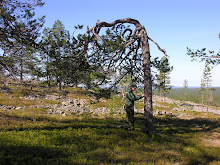One of the questions I keep on hearing is: what is the Cajanus tube and how it is used? Actually it is all very simple, but in scientific articles there is never enough space to describe everything comprehensively. So hopefully this will make things clearer.
At least in this case one image tells more than tens of words, so this is how the Cajanus tube looks like:

As you see, it is little like a periscope, but it is used for looking upwards. The balancing system at the top keeps the tube leveled, and the user looks vertically through the tube that has a small mirror (placed at 45 degrees angle) at the bottom and a crosshair at the top. The whole system is usually placed on a supportive staff. This allows the measurer to define exactly whether some point is covered by the canopy. It can be used for measuring crown radiuses or canopy cover. In canopy cover estimation the standard method is to establish some transects in the study plot, and then measure the percentage of the transect covered by the crowns.
The Cajanus tube has already a long history. It was designed by Werner Cajanus, who was the first professor in forest inventory in Finland, already in the 1910’s for use in crown radius measurements. Risto Sarvas showed how it can be used for canopy cover measurements in the 50’s, but after that I have not found any Finnish publications until LAI detectives. Actually nobody of our forest inventory staff here in Joensuu had even seen a Cajanus tube before I borrowed the one in the picture from Metla’s Suonenjoki research station.
The final question of an interested reader should now be “where to get one?” As far as I know, nobody makes these anymore. There is one fairly similar commercial version called the GRS densitometer, but it is nowhere as useful as the Cajanus tube, because it has no self-leveling system (the user must use the in-built leveling bubbles to keep it vertical). So the remaining option is to build one with your own hands – for example plywood and mirror can be used for the tube, and the leveling system can be made of some screws and iron bars. Or maybe an average researcher should just find someone handier to do the job…
At least in this case one image tells more than tens of words, so this is how the Cajanus tube looks like:

As you see, it is little like a periscope, but it is used for looking upwards. The balancing system at the top keeps the tube leveled, and the user looks vertically through the tube that has a small mirror (placed at 45 degrees angle) at the bottom and a crosshair at the top. The whole system is usually placed on a supportive staff. This allows the measurer to define exactly whether some point is covered by the canopy. It can be used for measuring crown radiuses or canopy cover. In canopy cover estimation the standard method is to establish some transects in the study plot, and then measure the percentage of the transect covered by the crowns.
The Cajanus tube has already a long history. It was designed by Werner Cajanus, who was the first professor in forest inventory in Finland, already in the 1910’s for use in crown radius measurements. Risto Sarvas showed how it can be used for canopy cover measurements in the 50’s, but after that I have not found any Finnish publications until LAI detectives. Actually nobody of our forest inventory staff here in Joensuu had even seen a Cajanus tube before I borrowed the one in the picture from Metla’s Suonenjoki research station.
The final question of an interested reader should now be “where to get one?” As far as I know, nobody makes these anymore. There is one fairly similar commercial version called the GRS densitometer, but it is nowhere as useful as the Cajanus tube, because it has no self-leveling system (the user must use the in-built leveling bubbles to keep it vertical). So the remaining option is to build one with your own hands – for example plywood and mirror can be used for the tube, and the leveling system can be made of some screws and iron bars. Or maybe an average researcher should just find someone handier to do the job…

3 comments:
This was a good and informative read, Lauri. I hope next time I will have a chance to see the real instrument.
Thank you
Jan
Hi, My students and I are interested in looking at canopy radius of existing large trees and how European Buckthorn infestation affects LAI in Minnesota forests. The Cajanus tube looks like a valuable tool for doing some of this work. We can make our own equipment but having more details about it's specs. and how you record the data would be useful.
Hi Weol! The tube that I currently use is rectangular and made of plywood. It's 30 cm high and 4.8 cm wide, but I guess it could be a bit smaller. The piece of wood holding the mirror is screwed inside, and under it is a 2.7 cm lead cube. The leveling system is made of welded iron, screws and nuts. The tube is attached to a support staff from a hole at the bottom of the rig with a winged nut and a washer. See the images at http://picasaweb.google.com/lakorhon/CajanusTube.
The use of tube in canopy cover measurements is described in this article: http://www.metla.fi/silvafennica/full/sf40/sf404577.pdf. For crown radius measurements, you need a laser rangefinder to measure the distance to stem, or an assistant with tape measure. I usually have a handheld field computer with excel where I put the results, but an assistant with paper form can certainly replace it.
Post a Comment